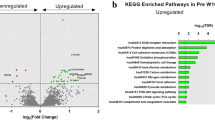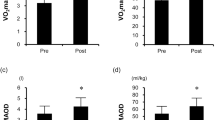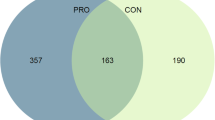Abstract
We hypothesized that in untrained individuals (n=6) a single bout of ergometer endurance exercise provokes a concerted response of muscle transcripts towards a slow-oxidative muscle phenotype over a 24-h period. We further hypothesized this response during recovery to be attenuated after six weeks of endurance training. We monitored the expression profile of 220 selected transcripts in muscle biopsies before as well as 1, 8, and 24 h after a 30-min near-maximal bout of exercise. The generalized gene response of untrained vastus lateralis muscle peaked after 8 h of recovery (P=0.001). It involved multiple transcripts of oxidative metabolism and glycolysis. Angiogenic and cell regulatory transcripts were transiently reduced after 1 h independent of the training state. In the trained state, the induction of most transcripts 8 h after exercise was less pronounced despite a moderately higher relative exercise intensity, partially because of increased steady-state mRNA concentration, and the level of metabolic and extracellular RNAs was reduced during recovery from exercise. Our data suggest that the general response of the transcriptome for regulatory and metabolic processes is different in the trained state. Thus, the response is specifically modified with repeated bouts of endurance exercise during which muscle adjustments are established.



Similar content being viewed by others
References
Andersen P, Henriksson J (1977) Capillary supply of the quadriceps femoris muscle of man: adaptive response to exercise. J Physiol 270:677–690
Bergstrom J, Hermansen L, Hultman E, Saltin B (1967) Diet, muscle glycogen and physical performance. Acta Physiol Scand 71:140–150
Bickel CS, Slade J, Mahoney E, Haddad F, Dudley GA, Adams GR (2005) Time course of molecular responses of human skeletal muscle to acute bouts of resistance exercise. J Appl Physiol 98:482–488
Booth FW, Baldwin KM (1996) Muscle plasticity: energy demanding and supply processes, Sect 12, Chap 24. In: Rowell LB, Shepherd JT (eds) Handbook of physiology. Oxford University Press, New York, pp 1075–1123
Brown MD, Hudlicka O (2003) Modulation of physiological angiogenesis in skeletal muscle by mechanical forces: involvement of VEGF and metalloproteinases. Angiogenesis 6:1–14
Carter SL, Rennie CD, Hamilton SJ, Tarnopolsky (2001) Changes in skeletal muscle in males and females following endurance training. Can J Physiol Pharmacol 79:386–392
Dapp C, Schmutz S, Hoppeler H, Fluck M (2004) Transcriptional reprogramming and ultrastructure during atrophy and recovery of mouse soleus muscle. Physiol Genomics 20:97–107
Denis C, Chatard JC, Dormois D, Linossier MT, Geyssant A, Lacour JR (1986) Effects of endurance training on capillary supply of human skeletal muscle on two age groups (20 and 60 years). J Physiol (Paris) 81:379–383
Fischer CP, Plomgaard P, Hansen AK, Pilegaard H, Saltin B, Pedersen BK (2004) Endurance training reduces the contraction-induced interleukin-6 mRNA expression in human skeletal muscle. Am J Physiol 287:E1189–E1194
Fluck M (2004) Exercise-modulated mitochondrial phenotype; sensors and gene regulation. J Muscle Res Cell Motil 25:235–237
Fluck M, Chiquet M, Schmutz S, Mayet-Sornay MH, Desplanches D (2003) Reloading of atrophied rat soleus muscle induces tenascin-C expression around damaged muscle fibers. Am J Physiol 284:R792–R801
Fluck M, Hoppeler H (2003) Molecular basis of skeletal muscle plasticity—from gene to form and function. Rev Physiol Biochem Pharmacol 146:159–216
Hood DA (2001) Invited review: contractile activity-induced mitochondrial biogenesis in skeletal muscle. J Appl Physiol 90:1137–1157
Hoppeler H, Howald H, Conley K, Lindstedt SL, Claassen H, Vock P, Weibel ER (1985) Endurance training in humans: aerobic capacity and structure of skeletal muscle. J Appl Physiol 59:320–327
Howald H, Hoppeler H, Claassen H, Mathieu O, Straub R (1985) Influences of endurance training on the ultrastructural composition of the different muscle fiber types in humans. Pflugers Arch 403:369–376
Ingjer F (1979) Capillary supply and mitochondrial content of different skeletal muscle fiber types in untrained and endurance-trained men. A histochemical and ultrastructural study. Eur J Appl Physiol Occup Physiol 40:197–209
Kraniou Y, Cameron-Smith D, Misso M, Collier G, Hargreaves M (2000) Effects of exercise on GLUT-4 and glycogenin gene expression in human skeletal muscle. J Appl Physiol 88:794–796
Larson DE, Zahradka P, Sells BH (1991) Control points in eucaryotic ribosome biogenesis. Biochem Cell Biol 69:5–22
Levy NS, Chung S, Furneaux H, Levy AP (1998) Hypoxic stabilization of vascular endothelial growth factor mRNA by the RNA-binding protein HuR. J Biol Chem 273:6417–6423
Malm C, Nyberg P, Engstrom M, Sjodin B, Lenkei R, Ekblom B, Lundberg I (2000) Immunological changes in human skeletal muscle and blood after eccentric exercise and multiple biopsies. J Physiol 529(Pt 1):243–262
Neufer PD, Ordway GA, Hand GA, Shelton JM, Richardson JA, Benjamin IJ, Williams RS (1996) Continuous contractile activity induces fiber type specific expression of HSP70 in skeletal muscle. Am J Physiol 271:C1828–C1837
Pilegaard H, Ordway GA, Saltin B, Neufer PD (2000) Transcriptional regulation of gene expression in human skeletal muscle during recovery from exercise. Am J Physiol 279:E806–E814
Pilegaard H, Saltin B, Neufer PD (2003) Exercise induces transient transcriptional activation of the PGC-1alpha gene in human skeletal muscle. J Physiol 546:851–858
Puntschart A (1994) Molekulare Adaptation des menschlichen Skelettmuskels an Ausdauertraining. Thesis/Dissertation. ETH Zürich
Puntschart A, Claassen H, Jostarndt K, Hoppeler H, Billeter R (1995) mRNAs of enzymes involved in energy metabolism and mtDNA are increased in endurance-trained athletes. Am J Physiol 269:C619–C625
Richardson RS, Wagner H, Mudaliar SR, Henry R, Noyszewski EA, Wagner PD (1999) Human VEGF gene expression in skeletal muscle: effect of acute normoxic and hypoxic exercise. Am J Physiol 277:H2247–H2252
Richardson RS, Wagner H, Mudaliar SR, Saucedo E, Henry R, Wagner PD (2000) Exercise adaptation attenuates VEGF gene expression in human skeletal muscle. Am J Physiol 279:H772–H778
Rosler K, Hoppeler H, Conley KE, Claassen H, Gehr P, Howald H (1985) Transfer effects in endurance exercise. Adaptations in trained and untrained muscles. Eur J Appl Physiol Occup Physiol 54:355–362
Sachs AB (1993) Messenger RNA degradation in eukaryotes. Cell 74:413–421
Saltin B, Henriksson J, Nygaard E, Andersen P, Jansson E (1977) Fiber types and metabolic potentials of skeletal muscles in sedentary man and endurance runners. Ann N Y Acad Sci 301:3–29
Schmitt B, Fluck M, Decombaz J, Kreis R, Boesch C, Wittwer M, Graber F, Vogt M, Howald H, Hoppeler H (2003) Transcriptional adaptations of lipid metabolism in tibialis anterior muscle of endurance-trained athletes. Physiol Genomics 15:148–157
Schrauwen-Hinderling VB, Schrauwen P, Hesselink MK, van Engelshoven JM, Nicolay K, Saris WH, Kessels AG, Kooi ME (2003) The increase in intramyocellular lipid content is a very early response to training. J Clin Endocrinol Metab 88:1610–1616
Seip RL, Angelopoulos TJ, Semenkovich CF (1995) Exercise induces human lipoprotein lipase gene expression in skeletal muscle but not adipose tissue. Am J Physiol 268:E229–E236
Seip RL, Mair K, Cole TG, Semenkovich CF (1997) Induction of human skeletal muscle lipoprotein lipase gene expression by short-term exercise is transient. Am J Physiol 272:E255–E261
Starkie RL, Arkinstall MJ, Koukoulas I, Hawley JA, Febbraio MA (2001) Carbohydrate ingestion attenuates the increase in plasma interleukin-6, but not skeletal muscle interleukin-6 mRNA, during exercise in humans. J Physiol 533:585–591
Tunstall RJ, Mehan KA, Wadley GD, Collier GR, Bonen A, Hargreaves M, Cameron-Smith D (2002) Exercise training increases lipid metabolism gene expression in human skeletal muscle. Am J Physiol 283:E66–E72
Turner DL, Hoppeler H, Claassen H, Vock P, Kayser B, Schena F, Ferretti G (1997) Effects of endurance training on oxidative capacity and structural composition of human arm and leg muscles. Acta Physiol Scand 161:459–464
Vissing K, Andersen JL, Schjerling P (2005) Are exercise-induced genes induced by exercise?. FASEB J 19:94–96
Wittwer M, Billeter R, Hoppeler H, Fluck M (2004) Regulatory gene expression in skeletal muscle of highly endurance-trained humans. Acta Physiol Scand 180:217–227
Wittwer M, Fluck M, Hoppeler H, Muller S, Desplanches D, Billeter R (2002) Prolonged unloading of rat soleus muscle causes distinct adaptations of the gene profile. FASEB J 16:884–886
Yan Z, Salmons S, Jarvis J, Booth FW (1995) Increased muscle carnitine palmitoyltransferase II mRNA after increased contractile activity. Am J Physiol 268:E277–E281
Acknowledgements
The support of the Swiss National Science Foundation (grant number 31-65276.01) and the University of Bern is gratefully acknowledged. Special thanks are addressed to Franziska Graber for assistance in morphometric analyses and Ruth Vock and Hans Howald for advice on the manuscript.
Author information
Authors and Affiliations
Corresponding author
Electronic Supplementary Material
Rights and permissions
About this article
Cite this article
Schmutz, S., Däpp, C., Wittwer, M. et al. Endurance training modulates the muscular transcriptome response to acute exercise. Pflugers Arch - Eur J Physiol 451, 678–687 (2006). https://doi.org/10.1007/s00424-005-1497-0
Received:
Revised:
Accepted:
Published:
Issue Date:
DOI: https://doi.org/10.1007/s00424-005-1497-0




